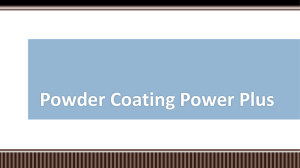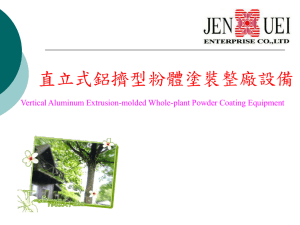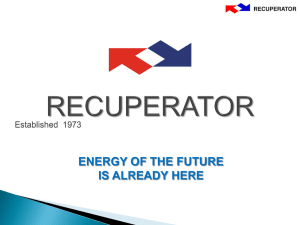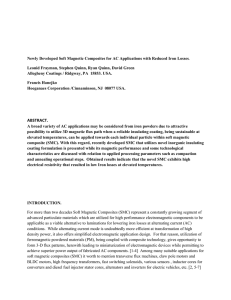Novel Soft Magnetic Composite for AC Applications with Reduced Total... Stephen Quinn Allegheny Coatings
advertisement
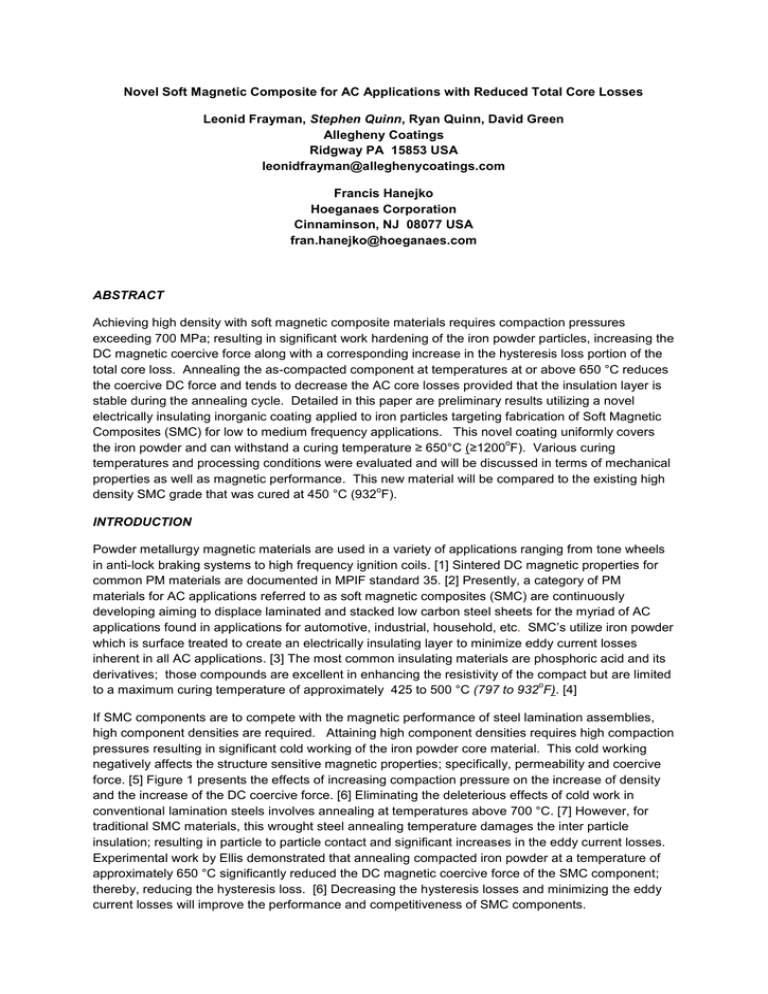
Novel Soft Magnetic Composite for AC Applications with Reduced Total Core Losses Leonid Frayman, Stephen Quinn, Ryan Quinn, David Green Allegheny Coatings Ridgway PA 15853 USA leonidfrayman@alleghenycoatings.com Francis Hanejko Hoeganaes Corporation Cinnaminson, NJ 08077 USA fran.hanejko@hoeganaes.com ABSTRACT Achieving high density with soft magnetic composite materials requires compaction pressures exceeding 700 MPa; resulting in significant work hardening of the iron powder particles, increasing the DC magnetic coercive force along with a corresponding increase in the hysteresis loss portion of the total core loss. Annealing the as-compacted component at temperatures at or above 650 °C reduces the coercive DC force and tends to decrease the AC core losses provided that the insulation layer is stable during the annealing cycle. Detailed in this paper are preliminary results utilizing a novel electrically insulating inorganic coating applied to iron particles targeting fabrication of Soft Magnetic Composites (SMC) for low to medium frequency applications. This novel coating uniformly covers o the iron powder and can withstand a curing temperature ≥ 650°C (≥1200 F). Various curing temperatures and processing conditions were evaluated and will be discussed in terms of mechanical properties as well as magnetic performance. This new material will be compared to the existing high o density SMC grade that was cured at 450 °C (932 F). INTRODUCTION Powder metallurgy magnetic materials are used in a variety of applications ranging from tone wheels in anti-lock braking systems to high frequency ignition coils. [1] Sintered DC magnetic properties for common PM materials are documented in MPIF standard 35. [2] Presently, a category of PM materials for AC applications referred to as soft magnetic composites (SMC) are continuously developing aiming to displace laminated and stacked low carbon steel sheets for the myriad of AC applications found in applications for automotive, industrial, household, etc. SMC’s utilize iron powder which is surface treated to create an electrically insulating layer to minimize eddy current losses inherent in all AC applications. [3] The most common insulating materials are phosphoric acid and its derivatives; those compounds are excellent in enhancing the resistivity of the compact but are limited o to a maximum curing temperature of approximately 425 to 500 °C (797 to 932 F). [4] If SMC components are to compete with the magnetic performance of steel lamination assemblies, high component densities are required. Attaining high component densities requires high compaction pressures resulting in significant cold working of the iron powder core material. This cold working negatively affects the structure sensitive magnetic properties; specifically, permeability and coercive force. [5] Figure 1 presents the effects of increasing compaction pressure on the increase of density and the increase of the DC coercive force. [6] Eliminating the deleterious effects of cold work in conventional lamination steels involves annealing at temperatures above 700 °C. [7] However, for traditional SMC materials, this wrought steel annealing temperature damages the inter particle insulation; resulting in particle to particle contact and significant increases in the eddy current losses. Experimental work by Ellis demonstrated that annealing compacted iron powder at a temperature of approximately 650 °C significantly reduced the DC magnetic coercive force of the SMC component; thereby, reducing the hysteresis loss. [6] Decreasing the hysteresis losses and minimizing the eddy current losses will improve the performance and competitiveness of SMC components. Figure 1 Effect of compaction pressure on component density and coercive force [reference 6] Figure 2 Effect of annealing temperature on coercive force [reference 6] Techniques developed to increase the ‘curing’ temperature of SMC materials utilize the use of MgO coatings, oxides created during the atomization of the iron powder and silicon based coating. [8, 9, 10] Each of these approaches, although good, has inherent drawbacks such as: increased compaction pressures to achieve a minimum density or high cost to produce. Other considerations for this coating are the relative ease of manufacturing, the uniform deposition of the coating on the powder, and the thermal expansion compatibility of the insulating coating with the iron powder substrate. The present study was initiated to exploit the use of a specially designed formulation of inorganic electrically insulating coating via direct deposition onto the iron powder. EXPERIMENTAL PROCEDURE High purity iron powder was pre-treated with a dilute solution of acid to remove surface oxidation and other impurities. The particulate mass was then heated in air at a temperature below the boiling point of water to facilitate the dispersion of the coating onto the surface of the iron powder. The novel SMC coating material and iron powder were mixed to uniformly disperse the coating. Once thoroughly mixed, the composite powder was dried and premixed with traditional powder lubricants o for subsequent compaction. For this initial study, all compaction was done at 93°C (199 F) die temperature utilizing compaction pressures of 830 MPa. Samples compacted were green strength bars (12.5 mm x 12.5 mm x 32 mm) and magnetic toroids (36 mm OD x 25 mm ID x 6 mm tall). The green strength bars were used to evaluate the green and cured density as well as resistivity of the material after the various curing conditions. The cured magnetic toroids were wrapped with 40 secondary turns and 200 primary turns of copper wire. Curing temperatures evaluated were 450°C (842°F), 540°C (1004°F), 650°C (1202°F), and 760 °C (1400°F) utilizing 100% nitrogen and a specially formulated gas atmosphere within the annealing furnace. In addition, transverse rupture strengths (TRS) were measured. Also, a dilatometer study was performed to investigate the coefficients of thermal expansion (CTE) of the novel insulating coating (film) vs. that of the pure iron. Results and Discussion Figure 3 presents the thermal expansion data of the researched SMC coating and a 7.2 g/cm³ green density high purity iron powder compacted with admixed pressing lubricants. The thermal expansion of the experimental coating is linear from room temperature to 750 °C. The compacted iron shows a non-linear behavior at 400 °C; this non-linearity is a result of lubricant burn-off. [10] Without the admixed lubricant the pure iron would also be linear. The significance of the coating and the iron powder compact having the same CTE is that this eliminates potential cracking of the coating during heating or cooling from the annealing temperature. Cracks in the coating will result in iron particle to iron particle contact; thus, creating eddy current losses and subsequent high AC magnetic losses. Figure 3 Figure 4 Coefficient of Thermal Expansion of iron powder and coating. Red line is the compacted iron powder and the blue line is the insulating coating material. Resistivity of SMC coating as a function of curing temperature Resistivity of the new material was evaluated as a function of annealing temperature and the results are shown in Figure 4. It has been suggested that maintaining a resistivity of at least 10,000 microohm-cm (µ-Ω-cm) will minimize eddy current losses under AC test conditions. The newly developed coating delivered a resistitivity of 17,000 µ-Ω-cm at 650 °C. This value was significantly higher than the standard AncorLam material at the same temperature and superior to the AncorLam at a 450 °C curing temperature. Increasing the annealing temperature of the experimental coating to 760 °C lowered the resistivity to a value <1000 µ-Ω-cm ; thus, annealing at 760 °C will result in excessive AC magnetic losses. [7] These initial results were developed in a curing atmosphere of 100% nitrogen. Additional experimentation was performed at 650 °C using a modified furnace atmosphere; the results of this modified atmosphere showed a resistivity of approximately 40,000 µ-Ω-cm. Magnetic toroids were compacted and annealed using the two atmospheres utilizing a temperature range up to 870 °C. The coercivity data at 1 Tesla for both DC and AC conditions (at 50 Hz) are shown in Figure 5. DC coercivity is an approximate measure of the hysteresis loss; thus, lower values are preferred. However, it is also important to keep the AC coercivity as low as possible because increasing Hc values in AC testing signify increasing eddy current losses. Ideally, the DC coercive force would be identical to AC coercive force measurement. For the unique SMC material evaluted in this study, the DC Hc decreases from 350 A/m at 450C to 200 A/m at 650 °C. At 650 °C, the Hc remained approximately equal for both DC and AC testing. This implies that the beneficial effect of annealing is maintained because the the unique insulation has not degraded. Annealing at 650 °C showed the largest decrease in Hc value from the as pressed condition. Increasing the annealing temperature to 760 °C and 870 °C produced only minor decreases in the DC coercive force from the 650 °C condition; however, the AC coercivity increased implying greater eddy current losses. Figure 5 Coercive force of unique coating measured via DC and AC (50 Hz) Table 1 presents the magnetic data for the standard AncorLam and the new material. At the present state of development, this new coating is thicker than the coating used in standard SMC type materials, resulting in lower as compacted density. This lower density exhibits reduced permeability, resulting in the need to use higher applied fields to achieve the same level of magnetic induction. The strength of the new coating is lower than the conventional SMC material. It is interesting that the higher annealing temperature show only minor increases in strength suggesting that the coating is mostly intact but regions of particle to particle contact must exist creating the higher losses. Strength improvement is an area for future development. Also presented in Table 1 is data documenting the magnetic performance utilizing the modified furnace atmosphere. This processing condition exhibited the lowest core loss properties of all the materials evaluated. This modified atmosphere combined with a 650 °C annealing cycle showed a total core loss at 50 Hz and 1 Tesla of 4.5 w/kg and at 400 Hz and 1 Tesla of 40 w/kg. There was a slight increase in the coercivity as the frequency increases from 50 to 400 Hz of 170 to 190 A/m. However, this minor increase implies that hysteresis losses are the major component of the total losses at 400 Hz and 1000 Hz. Shown in Figure 6 is the metallographic analysis of this the novel SMC coating after annealing at 650 °C. A well-defined particle coating is evident surrounding each particle. Table 1 Magnetic Data for Various Materials Novel Coating material 100% nitrogen atmosphere AncorLam Modified Atmos. Annealing Temperature, °C Measured Characteristic 450 650 450 650 760 650 Density 7.45 7.45 7.2 7.2 7.25 7.26 Perm 500 800 140 185 200 190 Hc (DC), A/m 340 190 340 190 190 165 Hc (50 Hz), A/m 370 >1000 350 210 272 170 Core loss, @ 50 Hz and 1 T, w/kg 6 30 9 5 8 4.5 Hc (400 Hz), A/m 400 >1000 390 330 720 190 Core Loss @ 400 Hz and 1T, w/kg 59 >1000 86 60 160 40 Core Loss at 1 kHz and 1 Tesla, w/kg 170 >1000 225 180 NA 110 124 (18000) >172 (>25,000) 29 (4250) 33 (4750) 44 (6330) 28 (4000) TRS, MPa (psi) Conclusions From this study the following conclusions can be made: 1. Curing at 650 °C substantially reduces the DC coercive force. Higher temperatures up to 870 °C show minor improvements above the 650 °C temperature. However, with the current level of development of the unique coating curing at 760 °C and above results in excessive eddy current losses and subsequently higher total losses. 2. A customized curing atmosphere facilitated the reduction of magnetic losses over the AC frequency range used in this study. Coincident with the reduction of losses was the corresponding decrease in the DC and AC coercivity. 3. Maintaining a bulk resistivity greater than 10,000 micro-ohm-cm with the concurrent ability to sustain increased annealing temperature are crucial factors to minimize iron losses within SMC for use in AC electromagnetic applications. Figure 6 Unetched microstructure of insulated material annealed at 650 °C References 1. H. Rutz, C. Oliver, F. Hanejko, “Effects of Processing and Materials on Soft Magnetic Performance of Powder Metallurgy Parts”, Advances in Powder Metallurgy and Particulate Materials – 1992, Metal Powders Industry Federation, Princeton, NJ, 1992, pp. 6-375. 2. MPIF Standard 35 2012 Edition, Material Standards for PM Structural Materials, Published by Metal Powder Industries Federation, Princeton, NJ, 2012, pp. 66 – 67. 3. T. Maeda, H. Toyoda, N. Igarashi, K. Hirose, K. Mimura, T. Nishioka, and A. Ikegaya, “Development of Super Low Iron-Loss P/M Soft Magnetic Material”, SEI Technical Review, No 60, June 2005, pp.3-9. 4. R. Nolan, “Electrically Insulating Phosphate Coatings for Iron Powder Based Electromagnetic Core Applications”, Massachusetts Institute of Technology, Department of Mechanical Engineering, 2009 - 24 pages 5. R. Bozorth, Ferromagnetism, Published by Van Nostrand Company, Princeton, NJ. 1951 p. 14. 6. F. Hanejko, G. Ellis, T. Hale, “Application of High Performance Material Processing – Electromagnetic Products”, PM2TEC'98 International Conference on Powder Metallurgy & Particulate Materials May 31-June 4, Metal Powders Industry Federations, 1998 pp. 7. F.J. G. Landraf, M.Emura, “losses and Permeability Improvement by Stress Relieving Fully Processed Electrical Steels with Previous Small Deformations:, Journal of Magnetism and Magnetic Materials, Nov 242-245, 2002, pp. 152- 156. 8. C. Elgelid, L. Westberg, A. Larson, US Patent # 6,562,458, 2003. 9. K. Narasimhan, C. Schade, “Iron-Silicon Water Atomized Powders for Electromagnetic Applications”, PM2014 World Congress on Powder Metallurgy and Particulate Materials, Metal Powder Industries Federation, 2014 Manuscripts Preprints. 10. P. Skoglund, O. Andersson, P. Knutnsson, H. Vidarsson, “Soft Magnetic Powder Composition Comprising Insulated Particles and a Lubricant Selected from Organo-Silanes, Titanates, Aluminates and Zirconates and Process for its Preparation”, International Patent Application WO 2004/056508 A1, 2004. 11. F. Semel, “Process Determining the Dimensional Change of PM Steels”, Advances in Powder Metallurgy and Particulate Materials - 2001, MPIF, Princeton, NJ, pp. 5-113 to 5-135.
